
Explore Pilgrimage Today

Discover more about the history of pilgrimage, and observe and experience the practice of pilgrimage today, by visiting some of the places discussed on this website.
This section (which will be expanded over time) contains:
- links to websites about historic pilgrim destinations
- links to websites which discuss pilgrimage-related topics such as medieval literature and history, pilgrim accounts, pilgrimage art and architecture
Some pilgrimage destinations
Canterbury Cathedral
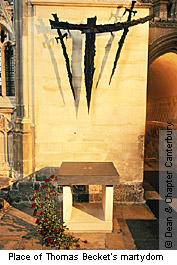
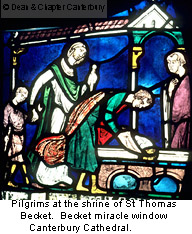
The Cathedral's history goes back to 597AD when St Augustine arrived in Kent, having been sent from Rome by Pope Gregory the Great to bring Christianity to the Anglo-Saxons. In time, Augustine built the first cathedral and became the first Archbishop of Canterbury. The Cathedral was rebuilt completely by the Normans in 1070 following a major fire and there have been many additions to the building during succeeding centuries. In 1170 Archbishop Thomas Becket was murdered in the Cathedral. Becket was swiftly declared a saint and pilgrims flocked to his shrine, to seek healing and other benefits and to give thanks. Strategically situated between the Channel ports and London, Canterbury attracted pilgrims, not only from all over the British Isles but from the Continent.
Though Becket's shrine was destroyed at the Reformation, visitors today can still see the place of his death, the Corona Chapel, and the stained glass windows in the Trinity Chapel and elsewhere which tell the story of the saint and the miracles associated with him. They can also see the many other examples of medieval stained glass and architecture, and join in the daily pattern of worship which has continued since the time of St Augustine.
Website: http://www.canterbury-cathedral.org/
Durham Cathedral
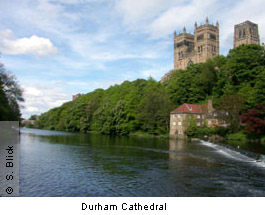
Durham Cathedral is acknowledged as a a masterpiece of Romanesque (or Norman) architecture. It was built on a a peninsula of land created by a loop in the River Wear, to house the shrine of the Anglo-Saxon saint and bishop, Cuthbert, whose reputation drew pilgrims came from all over England. It was also the home of a Benedictine monastic community. Although the shrine was destroyed during the Reformation, some of the relics found in the saint's tomb survived and were recovered in 1827. These include the stole of St Cuthbert, his pectoral cross (gold inset with garnets), an ivory liturgical comb, and a leather-bound Gospel of St John.
Durham Cathedral still attracts many pilgrims. Today visitors can see the tombs of Cuthbert and Bede (the greatest scholar-monk of the Anglo-Saxon period), view the relics associated with Cuthbert displayed in the Treasury, and participate in the daily pattern of prayer which is part of the cathedral's spiritual heritage.
Website: http://www.durhamcathedral.co.uk/
Santiago de Compostela

Santiago de Compostela was one of the great pilgrimage destinations of the Middle Ages. The story seems to have begun in the seventh century with the belief that the apostle St James the Great had preached in the peninsula. Gradually the legend that he was buried there, at Santiago de Compostela in the far north-west of Spain came inot being and attracted the support of bishops and kings. The popularity of the pilgrimage was probably at its height in the twelfth century, when it came to rival Rome and Jerusalem. A very large number of Compostela souvenirs (mostly scallop-shells,) have been found in England and elsewhere in Europe.
Compostela still attracts very large numbers of pilgrims today, having undergone a considerable revival during the closing decades of the twentieth century. In 1986, 2,491 people were awarded the compostela or pilgrim certificate, as evidence that they had walked or ridden on horseback the last one hundred kilometres to the shrine (or cycled the final 200 km), and had undertaken their journey from a religious or spiritual motivation. Ten years later the number had risen to 23,218. In 1999, which was a Holy Year, the figure was 154,613. In 2004, another Holy Year, the number reached 179,944. Pilgrims who wish to gain the compostela are required by the cathedral authorities in Santiago to carry the credencial (pilgrim passport) and to have it stamped and dated at each stage of the journey. There are pilgrim hostels or refugios along the route.
http://www.csj.org.uk/
http://www.americanpilgrims.com/
http://www.santiago-compostela.net/
http://www.xacobeo.es/
Walsingham
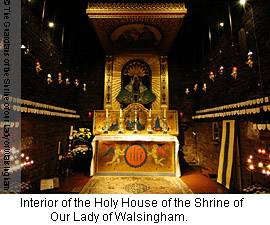
In 1061 a wealthy widow, Richeldis de Faverches, is said to have seen a vision of Virgin Mary who asked her to build a replica of the house where the angel Gabriel had announced that Mary would be the mother of Jesus. After some difficulties, the house was duly built in Walsingham. In the second half of the twelfth century, Walsingham also acquired a small wooden statue of a seated Virgin and Child which was believed to work miracles. In 1300, crusaders gave a vial believed to contain the Virgin's breast milk. These wonders attracted large numbers of pilgrims to Walsingham from England and Europe, including English royalty and nobles. Erasmus noted in 1513 that it was 'the most frequented place throughout all England'.
The Holy House and the images were destroyed at the Reformation. In the nineteenth century, however, interest in the site was revived, the shrine was re-founded by Pope Leo XIII, and the modern -day pilgrimage began. Anglican interest in the shrine grew in the 1920s and in 1931 a new image of the Virgin, based on the seal of the Priory, was placed in a new 'holy house'. Today large numbers of pilgrims visit Walsingham'.
Website: http://www.walsingham.org.uk/
Westminster Abbey
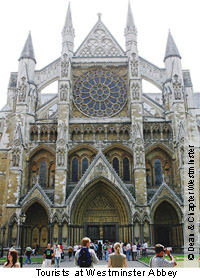
Originally a small Benedictine monastery founded c.960, Westminster Abbey has, through the centuries, been the burial places of royalty, statesmen, poets and priests.
The abbey underwent major development under Edward the Confessor (1042-1066), whose shrine it eventually became. Henry III (1207-1277), in his turn, had the Abbey almost entirely rebuilt. Edward's body was moved to a magnificent new shrine behind the High Altar and Henry and a number of other royal figures were subsequently buried nearby, their tombs clustered around that of the royal saint. In the Middle Ages, the abbey owned a vast collection of 'relics', including the footprints left by Jesus when he ascended to heaven, a comb of St Dunstan, the Stone of Scone (identified as Jacob's pillow), the girdle of the Virgin, and a vial of the Holy Blood of Christ.
Though most of the relics were lost at the Reformation, the Abbey remains a treasure house of paintings, stained glass, pavements, textiles and other artefacts. Visitors can take part in guided tours, follow audio guides, visit the Museum or choose to join in the daily pattern of worship.
Website: http://www.westminster-abbey.org/
York Minster
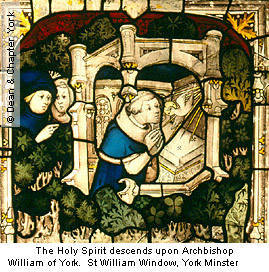
York Minster has been a site of pilgrimage and spiritual journey since the foundation of the earliest Minster in AD 627 by Saint Paulinus, when a baptistery was constructed to receive King Edwin into the Christian church. Throughout the mediaeval period, pilgrims came to the Minster in search of specific relics, such as fragments of what was believed to be the True Cross, as well as the physical remains of saints. A major focus was the shrine of St William Fitzherbert of York, a twelfth-century archbishop and York's only local saint prior to the Reformation. The story of William's life is told in the magnificent St William window which has recently been restored. Veneration of Archbishop Richard Scrope, executed for high treason on 8th June 1405 but never officially canonised despite strong local support, also drew pilgrims until 1541. All this changed at the Reformation.
Today people come to the Minster from all over the world. Some arrive from local churches in groups to experience a pilgrimage around the Minster; some come as part of a longer journey which encompasses other sites such as Whitby Abbey; others come alone. Many come primarily as tourists or students to explore the rich architectural and artistic heritage to be found in the largest Gothic cathedral in northern Europe.
Website: http://www.yorkminster.org/
Other Useful Websites
Pilgrim accounts through the centuries
University of Colorado Department of History 'Travelling to Jerusalem' website
http://chass.colostate-pueblo.edu/history/seminar/seminar97.html
Pilgrimage Art and Architecture
The International Society for the Study of Pilgrimage Art
http://peregrinations.kenyon.edu/
Literature
Chaucer Metapage
http://www.unc.edu/depts/chaucer/



